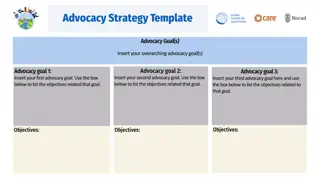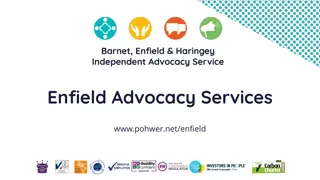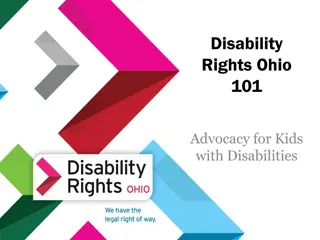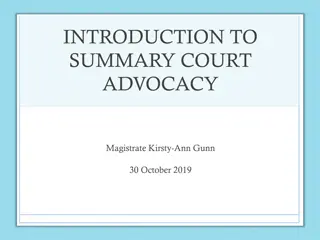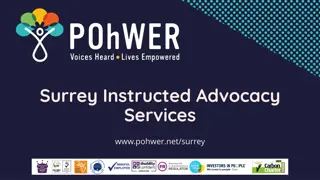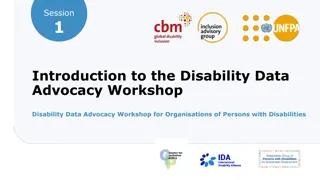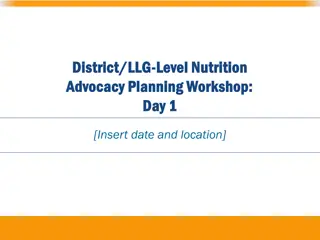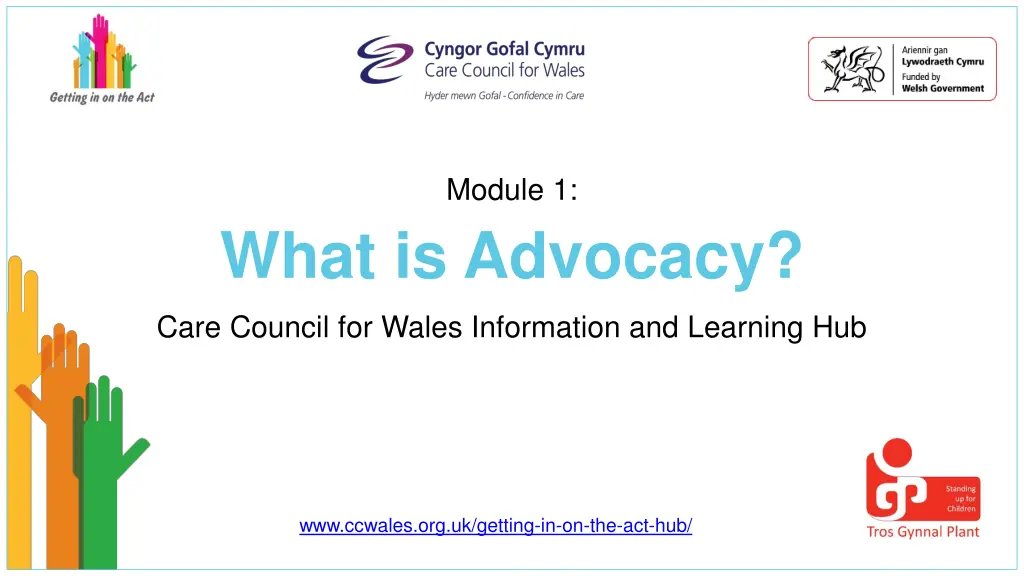
Understanding Advocacy in Care: Importance and Impact
Discover the essence of advocacy in care through explanations, real-life examples, and exercises. Explore the role of advocacy in empowering individuals, ensuring rights are upheld, and voices are heard. Learn about different advocacy approaches and the difference advocacy can make in various contexts.
Download Presentation

Please find below an Image/Link to download the presentation.
The content on the website is provided AS IS for your information and personal use only. It may not be sold, licensed, or shared on other websites without obtaining consent from the author. If you encounter any issues during the download, it is possible that the publisher has removed the file from their server.
You are allowed to download the files provided on this website for personal or commercial use, subject to the condition that they are used lawfully. All files are the property of their respective owners.
The content on the website is provided AS IS for your information and personal use only. It may not be sold, licensed, or shared on other websites without obtaining consent from the author.
E N D
Presentation Transcript
Module 1: What is Advocacy? Care Council for Wales Information and Learning Hub www.ccwales.org.uk/getting-in-on-the-act-hub/
Learning outcomes for this session By the end of this session learners will be able to: Explain what is meant by the term advocacy Describe and compare current advocacy approaches Recognise what an effective advocate does/does not do Describe the advocacy process and identify key considerations for the advocate at each stage
The difference advocacy can make I could be involved in a way I have never been able to before. People had to give me an answer instead of just ignoring me. Ellie, 12 John, 46, learning difficulties It was lovely to be able to help him prepare and go with him so he was less nervous It was empowering for both her and me Phil, health professional Clare, neighbour
Well-being statements Securing rights and entitlements Physical and mental health, and emotional well-being Protection from abuse and neglect Education, training and recreation Domestic, family and personal relationships Contribution made to society Social and economic well-being Suitability of living accommodation
What is advocacy? about speaking up for children and young people. about empowering children and young people to make sure that their rights are respected and their views and wishes are heard at all times. about representing the views, wishes and needs of children and young people to decision-makers, and helping them to navigate the system. National Standards for the Provision of Children s Advocacy Services Welsh Assembly Government, February 2003
What is advocacy? Advocacy supports and enables people who have difficulty representing their interests to exercise their rights, express their views, explore and make informed choices. Older People s Advocacy Alliance (OPAAL) National Forum, 2008 Advocacy is taking action to help people say what they want, secure their rights, represent their interests and obtain services they need. Action for Advocacy, 2002
Principles of advocacy Person-led Independent Supporting the person to speak out Non-judgemental Empowering Confidential
Types of advocacy 2. Formal advocacy Some broader professional roles have an element of advocacy within them. The professional can support the individual to express their views and wishes while separately expressing their own professional views or judgements. 1. Peer advocacy An individual might look for advocacy support from someone who understands their situation because they ve been there or are in similar circumstances to themselves. 3. Informal advocacy An individual may seek advocacy support from someone they know on an informal basis. This type of advocacy forms part of a broader emotional relationship where the advocate may have their own strong feelings about what s best for the individual. 4. Independent Professional Advocacy An individual may be able to access an advocate whose job is to provide them with independent support to get their voice heard regardless of their own views or opinions of the situation.
Exercise 3: Types of advocacy Professional Formal Peer Informal Availability Degree of independence Non-judgemental Emotional involvement Potential for conflict of interest Respect for confidentiality Who might provide
Exercise 4: The advocacy process What does advocacy look like ?
The advocacy process supports the individual by: 1. Hearing their story clarifying the issue 2. Helping them access accurate information 8. Making positive endings when the advocacy relationship ends 3. Establishing what their preferred outcome is 7. Helping them to understand outcomes 4. Helping them explore options including processes involved in each 6. Helping them to tell others what they want 5. Helping them to decide what they want including all potential outcomes
Concluding statements What is advocacy? Why is advocacy important? Do you or could you act as an advocate in your current role?
Learning outcomes for this session By the end of the session learners will be able to: Explain what is meant by the term advocacy Describe and compare current advocacy approaches Recognise what an effective advocate does/does not do Describe the advocacy process and identify key considerations for the advocate at each stage

